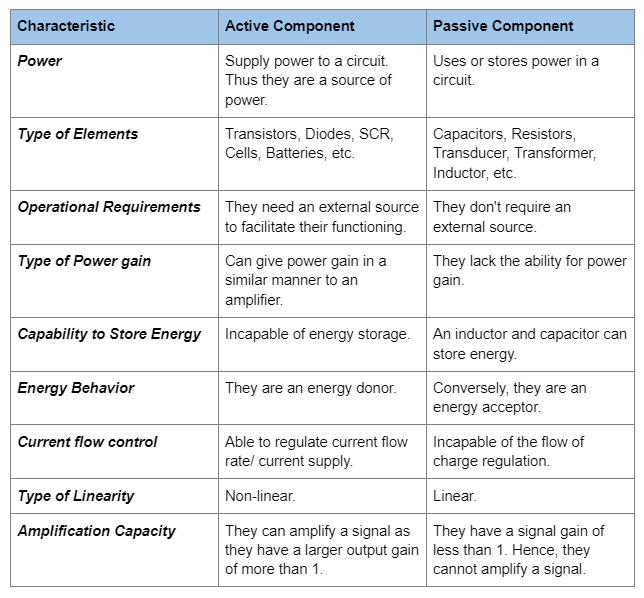All electronic circuits have active or passive elements that are essentially the building blocks of any electronic device. Hence, they are the cardinal prerequisites for the functioning of all electrical components. This article aims to give an elaborate distinction between active VS passive components. Further, it'll expound on the respective roles of the two electronic components in complete circuits.
Contents
- Types of Electronic Components
- Common examples of active components
- Current sources
- Voltage sources
- Transistors
- Common Examples of Passive Components
- Resistors
- Inductors
- Capacitors
- Transformers
- Active vs passive components: Difference between Active and Passive Components
- Circuit Symbols of Active and Passive Electronic Components
- Typical applications of active and passive components
- Summary
Types of Electronic Components
Different Electronic Components
Some electrical components have electrical resistance while others are ideal conductors/ lack electrical resistance. We can subdivide them into two primary categories. Fundamentally, the classification relies on the electronic components' capacity to absorb or deliver electrical power/energy. Hence, all components in an electric circuit are either;
- Active components or
- Passive devices.
Usually, electric symbols are the common representations of both types of electronic components when drawing electrical circuits.
Common examples of active components
Active components deliver electrical signal/ electrical energy to a circuit. Therefore, an active element can electrically manage the rate of electron flow. Essentially, the ability to manipulate the flow of charge is so cardinal that all electronic circuits must feature one active element. The following are some key active components:Current sources
Voltage sources
A voltage generator is also a source of energy. When there is a current flow from a voltage source's positive terminal, the generator acts as an active device. Thus, by our definition of an active source, a battery will be categorized as an active element. Primarily, a battery is a source of energy as it discharges.Transistors
Several transistors
All transistors, including MOSFETs, FETs, bipolar junction transistors, and JFETs, are active components. While they do not operate similarly to voltage and current sources, they amplify an electrical signal. Hence, all types of transistors play an active part in controlling the flow of electrons. Other Examples of active elements include the following:
- Generators/ Power sources of alternating and DC current like Alternators or DC generators
- Different types of Diodes, e.g., Schottky Diodes, Zener Diodes, Vacuum Diode, Tunnel diodes, and FETs.
- Display devices, e.g., CRT displays and LEDs.
- Chips and Microchips.
Special Offer: Get $100 off your order!
Email [email protected] to get started!
Common Examples of Passive Components
Passive components in a circuit are electrical components that act as energy recipients. Consequently, they may dissipate or store/absorb the electrical energy in an electric/ magnetic field. Besides, passive components will function even without any electrical power. Also, since they play a passive role, they don't contribute to generation, amplification, oscillation, or signal gain. They include the following discrete components:Resistors
Several resistors on a motherboard
Resistors are passive as they deliver no energy but rather receive an input signal. Subsequently, a resistor sheds this energy in the form of heat.
Inductors
An inductor is passive as it stores energy in a magnetic field, and while it can deliver energy, the supply is not continuous. Hence, it passes as a passive element due to its limited energy delivery and the transient nature of the delivery.Capacitors
Like inductors, capacitors only store energy in a limited and transient manner.Transformers
A Powerful Transformer
Perhaps, it is surprising that transformers are passive elements as they control the decrease in amplification and increase of the supply voltage. Nonetheless, the power and energy remain constant during this voltage drop or rise. Thus, the inability to change the power output qualifies a transformer as a passive component.
Active vs passive components: Difference between Active and Passive Components
The table below gives the key differences between the two types of electrical components.
Circuit Symbols of Active and Passive Electronic Components
Electric symbols are essential in representing active and passive electronic components in basic circuits or integrated circuits. Here are symbols of some of the common components in electronics.Electric symbols
Typical applications of active and passive components
- Computing power
- Built-in battery
- Display
- LED lights.
Similarly, there's a bottomless list of components in electronics that you can consider passive elements. They include the following:
- Incandescent light bulbs
- Loud-speakers
- Sensors
- Remote keyless entry systems
- Antennas in public transport systems, GPS devices, wireless modems, etc.
Summary
In a nutshell, active components and passive ones are the two primary classifications of ideal conductors. Any active component functions as an energy source and features an amplification factor. Conversely, the term passive refers to components that receive and store energy but don't produce any electrical charge. Finally, contact us for additional insights into electronics and the assembly process for different elements.Special Offer: Get $100 off your order!
Email [email protected] to get started!












